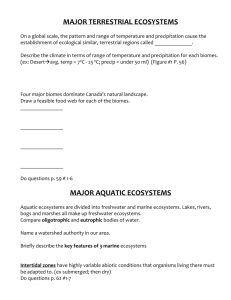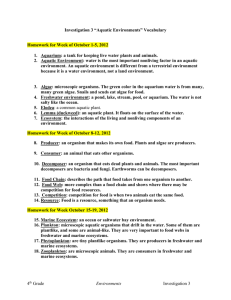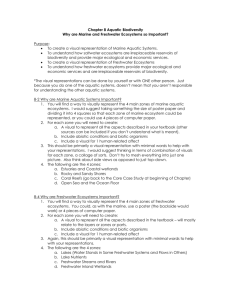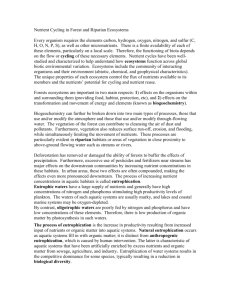Marine & Aquatic Ecosystems: Presentation Overview
advertisement
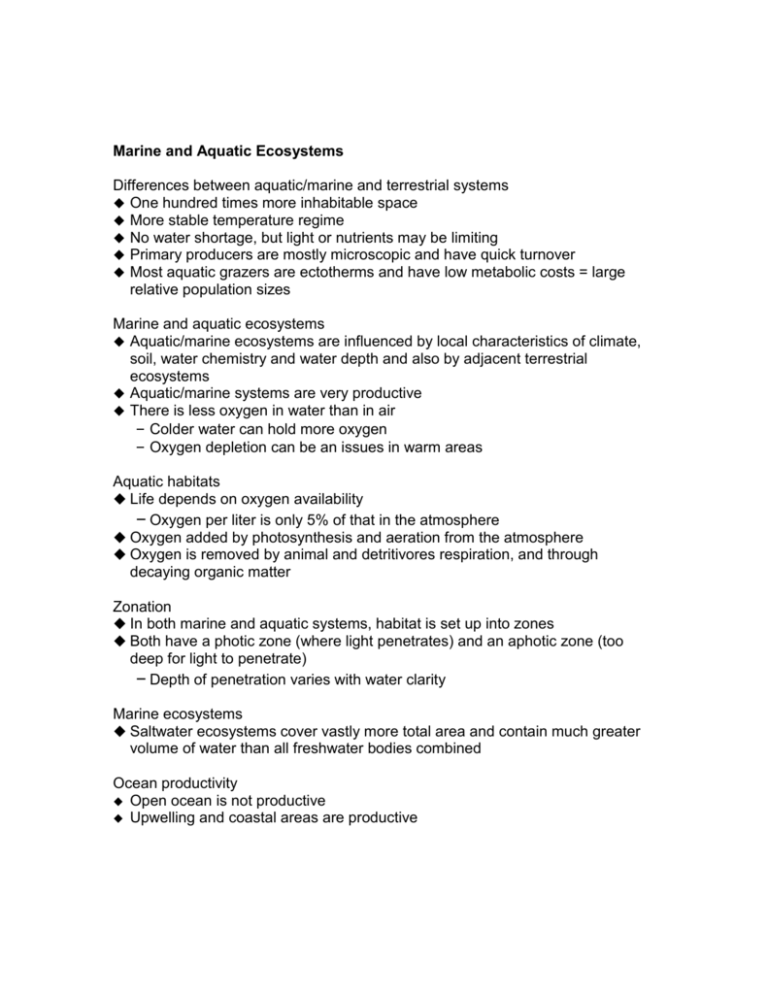
Marine and Aquatic Ecosystems Differences between aquatic/marine and terrestrial systems One hundred times more inhabitable space More stable temperature regime No water shortage, but light or nutrients may be limiting Primary producers are mostly microscopic and have quick turnover Most aquatic grazers are ectotherms and have low metabolic costs = large relative population sizes Marine and aquatic ecosystems Aquatic/marine ecosystems are influenced by local characteristics of climate, soil, water chemistry and water depth and also by adjacent terrestrial ecosystems Aquatic/marine systems are very productive There is less oxygen in water than in air – Colder water can hold more oxygen – Oxygen depletion can be an issues in warm areas Aquatic habitats Life depends on oxygen availability – Oxygen per liter is only 5% of that in the atmosphere Oxygen added by photosynthesis and aeration from the atmosphere Oxygen is removed by animal and detritivores respiration, and through decaying organic matter Zonation In both marine and aquatic systems, habitat is set up into zones Both have a photic zone (where light penetrates) and an aphotic zone (too deep for light to penetrate) – Depth of penetration varies with water clarity Marine ecosystems Saltwater ecosystems cover vastly more total area and contain much greater volume of water than all freshwater bodies combined Ocean productivity Open ocean is not productive Upwelling and coastal areas are productive Marine ecosystems Vertical stratification is an important aspect of many aquatic ecosystems – Organisms tend to form distinctive vertical sub-communities Neritic – Coastal shallow waters over continental shelves Benthic - Bottom sub-community – Low oxygen levels Pelagic - Water column Neritic zone Coral Reefs - Accumulated calcareous skeletons of colonial organisms (coral) – Depth limited by light penetration – Among most endangered communities Georges Banks Intertidal region Part of the neritic zone that is exposed due to tides Also called littoral zone Rocky intertidal zones are well-studied Mangroves Mangrove trees grow in salt water – Occur along calm, shallow, tropical coastline Other coastal habitats Barrier Islands - Low, narrow, sandy islands that form offshore from a coastline – Protect inland shores from surf – Prized for human development Loss of vegetation triggers erosion Estuaries Estuaries - Bays or semi-enclosed bodies of brackish water that form where rivers enter the ocean Important for fish and shellfish reproduction Pelagic zone Consists mostly of plankton – Small animals, algae, bacteria, etc. – Photosynthetic plankton account for 40% of all photosynthesis on earth – Photosynthetic plankton live in top 100 m of ocean where light penetrates Nekton are larger organisms Nekton Benthic zone Benthic zone in coastal areas Benthic zone in open ocean is a stressful environment – Rely on food scraps from world above – Seasonless, 2-5˚C, pressure of 400-500 atms – Some are chemoautotrophic –hydrothermal vents with sulfur oxidizing bacteria Freshwater habitats Strongly connected to terrestrial systems Large amount of material enters water from surrounding land Small water bodies are ponds (shallow enough for rooted vegetation throughout), larger water bodies are lakes – but line between them is not definitive Freshwater ecosystems Lakes – Non-flowing water – Freshwater lakes have distinct vertical zones separated by temperature Rivers – Flowing water Lakes Lakes have three zones that depend on depth and distance from shore – Littoral zone – Limnetic zone – Profundal zone Lake stratification Lakes form layers in summer due to temperature differences and lack of circulation – Water is most dense at 4˚C and least dense at 0˚C These two zones are called the epilimnion (warmer surface water) and the hypolimnion (colder deep water) The thermocline, an abrupt change in temperature, separates these two layers Nutrients accumulate in hypolimnion Thermal stratification tends to cut off the oxygen supply to bottom waters leading to anoxia in oxygen depleted waters Turnover Turnover mixes these two stagnant layers Lake productivity Lakes can be classified based on their levels of productivity – Eutrophic – lots of nutrients and organic matter – Oligotrophic – nutrients and organic matter are scarce Plant nutrients and cultural eutrophication Eutrophication - Process of increasing nutrient levels and biological productivity – Some amount of eutrophication is normal Cultural eutrophication - Increase in biological productivity and ecosystem succession caused by human activities Eutrophication Eutrophication Wetlands Land surface is saturated or covered with water at least part of the year – Swamps, bogs, marshes, etc. One of most productive ecosystems on earth Trap and filter water - “nature’s kidney’s” Provide flood control Wetlands
